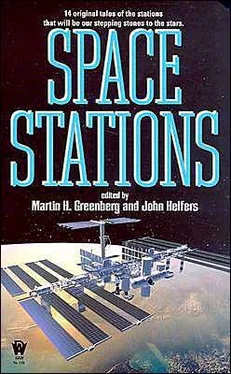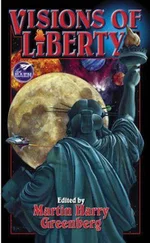SPACE STATIONS
Edited by Martin H. Greenberg and John Helfers
STEPPING STONES TO THE STARS….
For forty-seven years humankind has been reaching for the stars, with satellites, rockets, space shuttles, and, of course, orbital space stations. It seems obvious that to make our way to the other planets in our own solar system, and ultimately to distant stars, we will need to establish permanent manned space habitats. But what form will such space stations take, and what fates will await travelers to these stations as well as those who live and work in them?
The fourteen tales included in this volume offer an extraordinary range of possibilities, including:
“Mikeys”—Don and Sas were the advance team, their mission to land on Deimos, and construct a space station so the next team could actually touch down on Mars and do the real exploring. No one could have foreseen just how important the Deimos station would become….
“The Franchise”—They had come to Hamilton Station to help rebuild, but it was soon obvious that Hamilton was determined to keep enemies and friends alike from getting in….
“Follow the Sky”—As a young child, she dreamed of flying to the Wheel, and from there to other worlds. But it was only by losing everything that she might make her dream come true….
INTRODUCTION
by John Heifers
It’s amazing what the human race can accomplish when we put our collective minds to something. Whether it’s exploration, fighting disease, inventing new technology, or changing society, mankind can be an awesome power when it chooses to be.
Consider space exploration, for example. While scientists have been studying the stars for centuries, getting a man to walk among them has been quite a different matter. As the study of our universe goes, it is one of the most recent fields of scientific endeavor, primarily because of the advances in technology that have made it feasible. Since the launch of the first satellite by the Soviet Union on October 4, 1957, the United States and the rest of the world have been looking to the skies, and the universe beyond, as the ultimate last frontier.
And what an incredible forty-seven years it’s been. Since the first space race between Russia and the United States, the world has seen men land on the Moon, the first unmanned exploration of the surface of Mars, China join the other space faring nations, and a renewed interest in the vast galaxy beyond our own planet.
Along with this activity comes new ways to study and explore space. From the Hubble space telescope to the Voyager and Galileo deep space probes, we have pushed farther and farther past the boundaries of what we once knew.
One of the best ways to do this is right in our own backyard, so to speak. No matter how sophisticated the technology, satellites and machines cannot replace man when it comes to exploration, at least, not completely. Space stations, platforms where men and women can study the galaxy around the clock, have become the best way to gain practical results from space, whether it is manufacturing new medicines and materials in the weightless conditions, or exploring the heavens and planning to use the space station as a jumping off point fop trips beyond.
There have been several permanently manned space stations during the history of space exploration. The Russians beat America into space again with the launch of the first orbiting station, Salyut, in 1971. A Russian crew was the first to live in space for approximately twenty-four days, but tragically died upon returning to Earth. The U.S.’s first space outpost, Skylab, was launched in 1973. It was not intended to be a permanent station, but was used to study long-term effects of space and weightlessness on humans and animals. The longest-running manned space station, the Russian Mir station, managed to stay aloft for fifteen years despite being used for years after its proposed duration and suffering several accidents that at times severely hampered its capabilities.
In 2001 Mir was guided back into Earth’s atmosphere, where it was destroyed.
The most exciting development in the field of manned space exploration today is the International Space Station, a joint project that began construction in 1998. Funded and supplied by sixteen countries around the world, its purpose is to create a permanent station to take the world’s space program into the next century and millennium. When the station is completed in 2006, we will have the best platform to begin the next stage of exploration, leading back to the Moon, perhaps to Mars, and beyond.
The ISS has fired the imaginations of people around the world, and science fiction authors are no different. Fourteen of today’s best writers have given us their ideas of what the next generation of space stations will look like. From Timothy Zahn comes a story of a station that everyone thought was past its prime, until the time came for it to take part in a most unusual battle. Alan Dean Foster explores a space station that takes care of even its smallest inhabitant in a very special way. Brendan DuBois takes us to a future Earth where the dream of space stations took a detour that grounded humanity forever. And Gregory Benford reveals a completely different view of a space station in our final story.
Fourteen visions of the future created by the finest authors of speculative fiction. So turn the page and prepare for adventures beyond your wildest imagination on these space stations of tomorrow.
THE BATTLE OF SPACE FORT JEFFERSON
by Timothy Zahn
Timothy Zahn was born in 1951 in Chicago and spent his first forty years in the Midwest. Somewhere along the way toward a Ph.D. in physics, he got sidetracked into writing science fiction and has been at it ever since. He is the author of over seventy short stories and twenty novels, of which his most well-known are his five Star Wars books: The Thrawn trilogy and Hand of Thrawn duology. His most recent book is the Star Wars novel Survivor’s Quest, published in 2004. Though most of his time is now spent writing novels, he still enjoys tackling the occasional short story. This is one of them. The Zahn family lives on the Oregon coast.
“EIGHTEENTH April, 2230,” Ranger Bob Epstein said into his log microphone.
“Morning report. Three more days to President Ukukho’s visit.”
He gazed with satisfaction at the sentence on the screen as he picked up his slightly stale bagel covered thinly with cream cheese. A little lox would have been nice, but lox was hard to come by on United Colonies Space Fort Jefferson.
Actually, pretty much everything was hard to come by on Space Fort Jefferson. Tourist-free tourist attractions, as he’d often been told over the past seven years, rated very low on the Park Service’s priority list.
He scowled as he set the bagel back onto its plate. It wasn’t a fair assessment, as he’d argued back for most of those same seven years. Granted, for much of its four-point-three-year orbit Space Fort Jefferson was largely deserted, with only its five-ranger crew here to keep the decks and empty weapons emplacements company.
But for the four months when its elliptical path carried it near the asteroid belt’s Anchorline Archipelago, there was quite a bit of activity on the old fort. Granted, it wasn’t Disney Ceres, but it was still busy enough to keep the rangers hopping. And even during the long down-time, there was always a trickle of visitors willing to endure the long and boring trip to set foot on a piece of genuine, if obscure, history.
But that was going to change now. Earth President Ukukho himself was on his way; and for the first time in a hundred years, someone in actual governmental authority was going to visit the station.
Читать дальше












